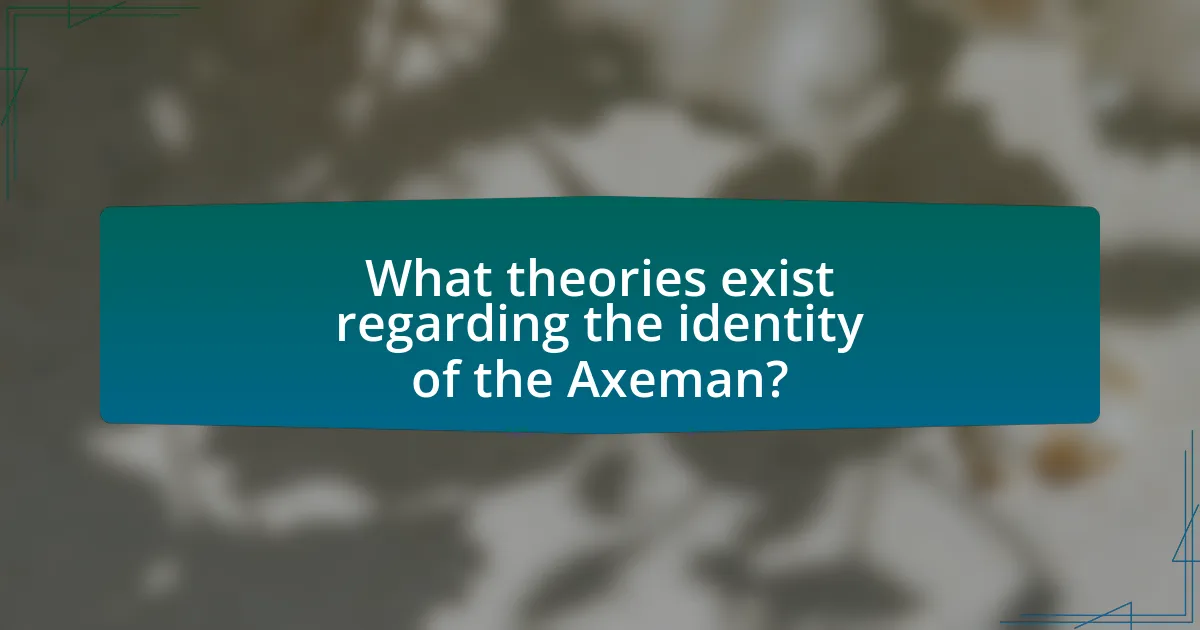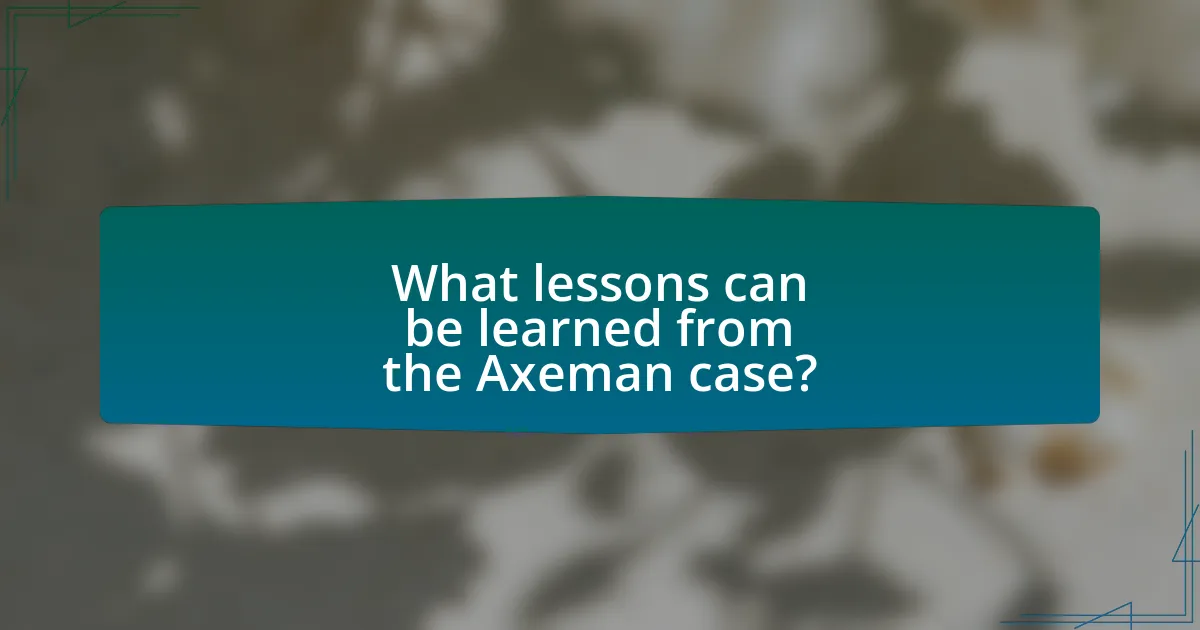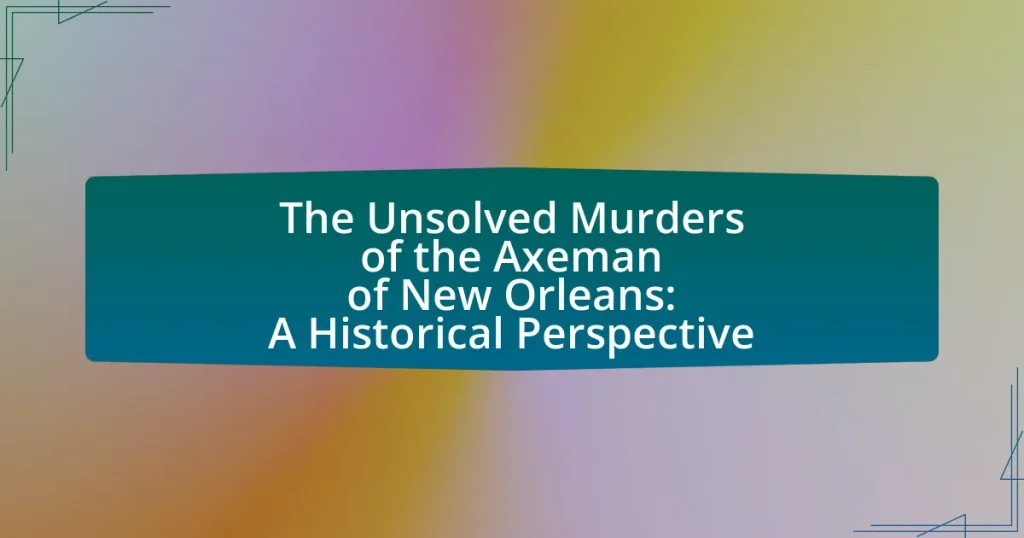The Axeman of New Orleans refers to a series of unsolved murders that took place between 1918 and 1919, where the perpetrator targeted Italian-American families using an axe. The article explores the characteristics of the Axeman’s crimes, the public’s fear and media sensationalism surrounding the case, and the challenges faced by law enforcement during the investigation. It also examines the cultural impact of the Axeman on New Orleans, including the rise of jazz music as a form of resistance, and discusses various theories regarding the identity of the killer. Additionally, the article highlights the lessons learned from this historical case and how they can inform modern criminal investigations.

What are the Unsolved Murders of the Axeman of New Orleans?
The unsolved murders of the Axeman of New Orleans refer to a series of brutal killings that occurred between 1918 and 1919, where the perpetrator, known as the Axeman, attacked victims with an axe, primarily targeting Italian-American families. The most notable victims include Joseph Maggio and his wife, who were murdered in their home in 1918, followed by several other attacks that resulted in fatalities and injuries, all characterized by similar methods and patterns. Despite extensive investigations and public fear, the identity of the Axeman was never discovered, and the case remains one of the most infamous unsolved murder sprees in American history.
How did the Axeman become a notorious figure in New Orleans history?
The Axeman became a notorious figure in New Orleans history due to a series of unsolved murders that occurred between 1918 and 1919, where he targeted Italian-American grocers and their families. His modus operandi involved breaking into homes and attacking victims with an axe, leading to widespread fear and panic in the community. The notoriety escalated when he sent a letter to a local newspaper, claiming he would spare anyone playing jazz music in their homes, which further captivated public attention and media coverage. The combination of brutal crimes, the mysterious identity of the killer, and the cultural significance of jazz music contributed to the Axeman’s lasting infamy in New Orleans history.
What time period did the Axeman’s murders occur?
The Axeman’s murders occurred between May 1918 and October 1919. During this time, the Axeman terrorized New Orleans, committing a series of brutal attacks primarily against Italian-American families. The specific timeframe is supported by historical records detailing the incidents and the public’s response, including newspaper coverage that documented the fear and panic in the community during this period.
What were the characteristics of the Axeman’s crimes?
The Axeman’s crimes were characterized by brutal attacks on victims, primarily targeting individuals in their homes during the night. The assailant used an axe, often belonging to the victims, to inflict fatal injuries, leading to a series of murders in New Orleans between 1918 and 1919. The crimes displayed a pattern of targeting Italian-American families, which created a climate of fear within the community. Additionally, the Axeman taunted the public and police through letters, claiming he would spare anyone playing jazz music, which added a psychological element to the terror he inflicted. These elements collectively highlight the violent and calculated nature of the Axeman’s criminal activities.
Why are the Axeman murders considered unsolved?
The Axeman murders are considered unsolved due to the lack of definitive evidence linking a suspect to the crimes and the absence of eyewitness accounts. Between 1918 and 1919, a series of brutal attacks occurred in New Orleans, resulting in several deaths, yet law enforcement was unable to identify the perpetrator despite numerous investigations. The killer’s identity remains unknown, and the case is complicated by the fact that many of the victims were part of the Italian immigrant community, which may have led to underreporting and reluctance to cooperate with authorities. Additionally, the Axeman’s taunting letters to the press and police further obscured the investigation, as they introduced confusion and misdirection.
What challenges did law enforcement face during the investigation?
Law enforcement faced significant challenges during the investigation of the Axeman of New Orleans, primarily due to a lack of forensic technology and limited resources. The absence of modern investigative tools, such as DNA analysis, hindered the ability to collect and analyze evidence effectively. Additionally, the police struggled with public panic and media sensationalism, which complicated their efforts to maintain order and gather reliable information. The investigation was further complicated by the fact that many witnesses provided conflicting accounts, making it difficult to establish a clear timeline or identify suspects. These factors collectively contributed to the inability of law enforcement to solve the murders, leaving the case unresolved.
How did public perception influence the investigation?
Public perception significantly influenced the investigation of the Axeman of New Orleans by creating immense pressure on law enforcement to solve the case quickly. The widespread fear and panic among residents led to increased media coverage, which in turn heightened public interest and scrutiny. This media frenzy prompted police to adopt more aggressive investigative tactics, including the formation of special task forces and the solicitation of public tips, as seen in the numerous letters received from citizens claiming to have information about the murders. Additionally, the Axeman’s own letters to the press, which taunted authorities and played on public fears, further complicated the investigation by diverting attention and resources. The combination of public anxiety and media sensationalism ultimately shaped the direction and urgency of the investigative efforts.
What impact did the Axeman have on New Orleans culture and society?
The Axeman significantly impacted New Orleans culture and society by instilling widespread fear and paranoia during his active years from 1918 to 1919. His series of brutal murders, primarily targeting Italian immigrants, led to a heightened sense of vulnerability among residents and prompted community discussions about safety and crime. The Axeman’s infamous letter to the local newspaper, in which he claimed he would spare anyone playing jazz music, sparked a cultural movement that celebrated jazz as a form of resistance against fear. This resulted in an increase in jazz performances and gatherings, embedding the genre deeper into the city’s cultural identity. The combination of terror and the subsequent embrace of jazz music illustrates how the Axeman’s actions shaped both the societal atmosphere and cultural expressions in New Orleans during that era.
How did the murders affect the local community?
The murders committed by the Axeman of New Orleans instilled fear and anxiety within the local community. Residents experienced heightened paranoia, leading to changes in daily routines and increased vigilance, as many believed they could be the next target. The series of brutal killings, which occurred between 1918 and 1919, resulted in a significant decline in business activity, particularly in the Italian neighborhoods where the majority of the victims resided. This economic downturn was evidenced by reports of empty storefronts and reduced foot traffic, as people avoided going out at night. Additionally, the murders sparked a wave of community solidarity, with residents forming neighborhood watch groups and organizing public meetings to discuss safety measures, reflecting a collective response to the pervasive threat.
What cultural artifacts emerged from the Axeman’s legacy?
Cultural artifacts that emerged from the Axeman’s legacy include music, literature, and visual art inspired by the infamous figure. The most notable artifact is the jazz song “The Axeman’s Jazz,” which reflects the fear and intrigue surrounding the Axeman during the early 20th century. Additionally, various books and articles have been written about the Axeman, contributing to the folklore and cultural narrative surrounding the unsolved murders. These artifacts serve as a testament to the lasting impact of the Axeman on New Orleans’ cultural landscape, illustrating how crime can influence artistic expression and community identity.

What theories exist regarding the identity of the Axeman?
Theories regarding the identity of the Axeman include several suspects, with the most notable being a local Italian immigrant named Joseph Mumfre, who was arrested but never charged, and a man named Andrew “The Axeman” B. who was rumored to have been involved in the murders. Additionally, some theories suggest that the killer may have been a member of a secret society or a disgruntled former employee of the victims. The Axeman’s identity remains a mystery, as no definitive evidence has conclusively linked any individual to the crimes, which occurred between 1918 and 1919 in New Orleans, resulting in at least six confirmed murders and several attacks.
How have various suspects been proposed over the years?
Various suspects have been proposed over the years in connection with the Axeman of New Orleans murders, including local residents, transient individuals, and even prominent figures. Investigators and the public have speculated about suspects such as Joseph Mumfre, a known criminal with a history of violence, and others like the Italian community members, who were often targeted due to racial and ethnic tensions during that era. Additionally, some theories have suggested that the killer may have been a member of the police force or a local businessman, reflecting the complex social dynamics of New Orleans in the early 20th century. These proposals have been fueled by eyewitness accounts, circumstantial evidence, and the cultural context of the time, leading to a wide array of theories that remain unresolved.
What evidence supports the theories about these suspects?
The evidence supporting theories about the suspects in the Axeman of New Orleans case includes eyewitness accounts, forensic analysis, and circumstantial evidence linking individuals to the crimes. Eyewitnesses reported seeing suspicious figures near the crime scenes, which led investigators to consider various suspects. Forensic analysis of the crime scenes revealed specific patterns, such as the use of an axe and the targeting of Italian-American families, suggesting a possible motive tied to organized crime. Additionally, letters purportedly from the Axeman, which were sent to local newspapers, hinted at the identity of the killer and provided clues that pointed towards certain suspects, including those with ties to the local Italian community. These elements collectively reinforce the theories surrounding the suspects in this unsolved case.
How have modern investigations approached the case?
Modern investigations into the Axeman of New Orleans case have utilized advanced forensic techniques and digital analysis to re-examine evidence. Investigators have employed DNA analysis on historical samples, which was not available during the original investigations in the early 20th century. Additionally, modern detectives have analyzed archived police reports and witness statements using data mining techniques to identify patterns and potential suspects. This approach has been supported by the use of geographic profiling to understand the Axeman’s movements and possible motivations, enhancing the understanding of the case’s context and the perpetrator’s behavior.
Why do some believe the Axeman was never caught?
Some believe the Axeman was never caught due to a combination of ineffective law enforcement, lack of forensic technology, and the chaotic social environment of New Orleans during the early 20th century. The police faced numerous challenges, including a high volume of crime and limited resources, which hindered their ability to investigate the murders effectively. Additionally, the Axeman’s ability to evade capture was facilitated by the anonymity of the city’s immigrant neighborhoods, where many of the attacks occurred. Historical records indicate that the Axeman’s last known murder took place in 1919, and despite numerous suspects and public interest, no conclusive evidence ever linked an individual to the crimes, leading to the belief that he remained at large.
What role did the media play in the Axeman’s notoriety?
The media played a crucial role in amplifying the notoriety of the Axeman by sensationalizing the murders and creating a climate of fear in New Orleans. Newspapers extensively covered the gruesome details of the crimes, often exaggerating facts to attract readership. For instance, the Times-Picayune published numerous articles detailing the Axeman’s modus operandi and even featured a letter purportedly from the killer, which further captivated the public’s imagination and heightened anxiety. This relentless media attention not only kept the Axeman in the public eye but also contributed to the mythos surrounding him, making the case one of the most infamous unsolved mysteries in American history.
How did the socio-political climate of the time affect the investigation?
The socio-political climate of early 20th century New Orleans significantly hindered the investigation into the Axeman murders. During this period, the city was marked by racial tensions, labor strikes, and a lack of effective law enforcement, which created an environment of fear and distrust among the populace. The police force was often seen as corrupt and ineffective, leading to a reluctance among citizens to cooperate with investigators. Additionally, the cultural backdrop of jazz and immigrant communities contributed to a chaotic atmosphere, complicating the gathering of reliable witness testimonies. This combination of factors resulted in a fragmented investigation, with crucial leads overlooked and potential suspects dismissed, ultimately allowing the Axeman to evade capture.

What lessons can be learned from the Axeman case?
The Axeman case teaches the importance of community vigilance and the need for effective law enforcement collaboration. The unsolved murders, which occurred between 1918 and 1919, highlighted how a lack of communication among police departments and insufficient investigative resources can hinder solving violent crimes. Additionally, the case underscores the impact of public fear and media sensationalism on crime perception, as the Axeman’s threats to target jazz musicians led to widespread panic in New Orleans. Historical records indicate that the Axeman’s identity remains unknown, emphasizing the necessity for ongoing advancements in forensic science and criminal profiling to prevent similar cases from remaining unresolved.
How can historical unsolved cases inform modern criminal investigations?
Historical unsolved cases can inform modern criminal investigations by providing insights into patterns of behavior, forensic techniques, and investigative strategies. For instance, the unsolved murders of the Axeman of New Orleans highlight the importance of understanding criminal psychology and the social context of the time, which can aid in profiling current suspects. Additionally, advancements in forensic science, such as DNA analysis, can be applied retrospectively to historical cases, potentially yielding new evidence that can influence modern investigations. The Axeman case also illustrates the significance of community engagement and media coverage in solving crimes, as public interest can lead to new tips and leads.
What techniques have evolved in criminal profiling since the Axeman’s time?
Since the Axeman’s time, techniques in criminal profiling have significantly evolved, incorporating advancements in psychology, technology, and forensic science. Modern profiling now utilizes behavioral analysis, which examines the psychological motivations behind criminal actions, and geographic profiling, which analyzes the locations of crimes to predict future offenses. Additionally, the integration of data analytics and artificial intelligence allows for the processing of vast amounts of information, enhancing the accuracy of suspect identification. For instance, the FBI’s Behavioral Analysis Unit employs these techniques to create detailed offender profiles based on crime scene evidence and victimology, which were not available during the early 20th century. These advancements have led to more effective investigations and a deeper understanding of criminal behavior.
How can community engagement improve crime-solving efforts today?
Community engagement can significantly improve crime-solving efforts today by fostering trust and collaboration between law enforcement and the community. When community members actively participate in crime prevention initiatives and share information, they enhance the flow of intelligence that can lead to solving cases. For instance, studies have shown that neighborhoods with strong community ties report higher levels of cooperation with police, resulting in increased crime clearance rates. According to the Bureau of Justice Statistics, community policing strategies have led to a 20% increase in crime-solving rates in areas where community engagement is prioritized. This collaborative approach not only empowers residents but also creates a safer environment, ultimately aiding in the resolution of crimes.
What resources are available for those interested in the Axeman of New Orleans?
Resources available for those interested in the Axeman of New Orleans include books, documentaries, and online articles. Notable books such as “The Axeman of New Orleans: The True Story” by Marcia Muller provide detailed accounts of the murders and the historical context. Documentaries like “The Axeman of New Orleans” available on streaming platforms offer visual insights into the case. Additionally, websites such as the New Orleans Historical website and various crime history blogs provide extensive articles and analyses of the Axeman’s impact on the city. These resources collectively offer a comprehensive understanding of the unsolved murders attributed to the Axeman.
Where can one find books and documentaries about the Axeman?
Books and documentaries about the Axeman can be found at major bookstores, libraries, and online platforms. Notable titles include “The Axeman of New Orleans: The True Story” by Miriam C. Davis and “The Axeman’s Jazz” by Ray Celestin, both available through retailers like Amazon and Barnes & Noble. Documentaries can be accessed on streaming services such as Amazon Prime Video and YouTube, where various programs explore the Axeman’s unsolved murders and historical context. These sources provide comprehensive insights into the Axeman’s story and its impact on New Orleans history.
What online forums or communities discuss the Axeman case?
Online forums and communities that discuss the Axeman case include Reddit, specifically the r/UnresolvedMysteries and r/TrueCrime subreddits, as well as dedicated Facebook groups focused on true crime and historical mysteries. These platforms allow users to share theories, historical context, and personal insights regarding the Axeman of New Orleans, which was a series of unsolved murders occurring between 1918 and 1919. The active participation in these communities provides a space for ongoing discussion and analysis of the case, contributing to a broader understanding of its historical significance.


